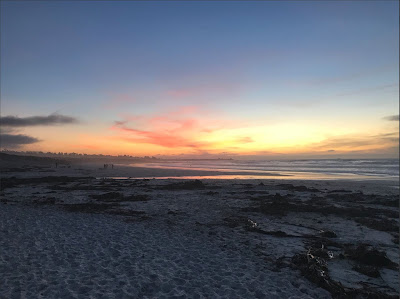CMC North 2017: Mathematical Language Routines
I still have sand in my shoes from CMC North this past weekend, and along with a major math hangover, that’s not a bad thing. I mean, check out this view:
I got the chance to try out a new session with a fantastic group of participants ranging from 3rd grade to high school teachers. Together we explored and experienced Mathematical Language Routines (MLR) from a powerful document that came out of UL/SCALE at Stanford this year. I first heard of MLRs when I was training to become a Master Coach for Illustrative Mathematics. Their new 6-8 open source curriculum uses MRLs as supports for English Learners in a way that amplifies, not simplifies, the language of the mathematics. In addition to providing scaffolds for students to access the language, the 8 MLRs provide opportunities and structures for students to develop and communicate their own language. Here’s a cheat sheet:
In my session we looked at a few of my favorite routines: Which One Doesn’t Belong? AKA WODB (an example of a Compare & Connect MLR), Information Gap Cards (and example of an Information Gap MLR), and Successive Pair Shares (an example of a Stronger & Clearer Each Time MLR). Here’s a few highlights from two of those.
In Which One Doesn't Belong?, students are shown four images and asked, “Which one doesn’t belong, and why?” Here’s an example from the 6th grade IM curriculum, along with prompts to support students in communicating their ideas:
This routine supports language development in many ways. First, the visual images are engaging and spark conversation. Second, there are many possible right answers. WODB tasks are designed so that a reason can be found why each choice doesn’t belong. Third, language supports can be offered to help students get started with their response and consider the responses of others. More WODB tasks can be found in the IM 6-8 curriculum, in Christopher Danielson’s book, and on WODB.ca.
Another routine we explored was Information Gap using Info Gap cards. The purpose of Information Gap is to give students a purpose to communicate. Students work in partners, with one receiving a Problem Card and one receiving an Info Card. Neither student has enough information to solve the problem on the card. Through questioning and justification, students elicit and share information, working towards solving the problem. Here’s an example of a 3rd or 4th grade Info Gap:
What I love about this routine is how it authentically gets students to collaborate. They know that the problem is solvable with both of their contributions, and have language support from the structure of the routine as well as their partner to get their ideas across. We posted this list of prompts and questions in 4th grade to support students with their conversation:
I'm looking forward to reflecting and refining this presentation (slides here) so I can roll it out again at NCSM and NCTM in DC in April!








Love your presentation PPT!
ReplyDeleteMathematical language routines boost understanding and communication skills, essential for mastering concepts in the P3 math syllabus.
ReplyDeleteRead more: P3 math syllabus